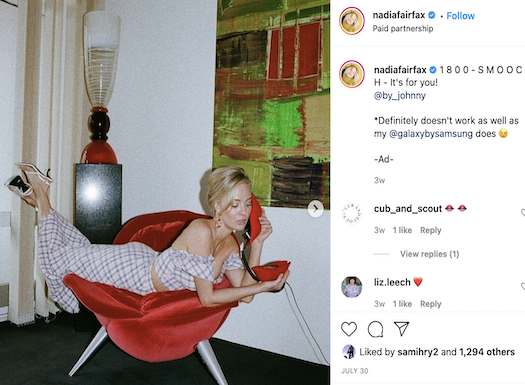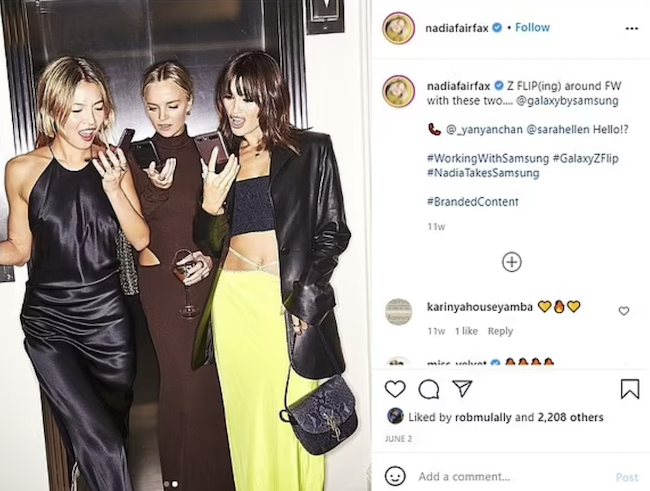Radio had its cash for comment moment twenty years ago, now it seems to be social media’s turn.
The Advertising Standards Council is cracking down on undeclared advertising in social media posts by ‘influencers.’
Social media influencer Nadia Fairfax, who has nearly 200,000 followers on Instagram and seems to post on average three to five times per week, was pinged for not declaring her paid sponsorship from Samsung in a post showing herself and two other socialites using Samsung Flip Phones.
The post did not declare a commercial relationship, although it did tag Samsung.
Fairfax has a promotional agreement with Samsung and posts many paid messages, which are usually declared, however this post did not declare any commercial interest. After the complaint to the Ad Standards body, a ‘Branded Content’ tag was added. The post, which had about 2500 likes, has now been removed.
The original caption read:
‘Z FLIP(ing) around FW with these two…. @galaxybysamsung @_yanyanchan @sarahellen Hello!? #WorkingWithSamsung #GalaxyZFlip #NadiaTakesSamsung.’ It also tagged the official ‘@galaxybysamsung’ account.
Ad Standards, which administers a national system of advertising self-regulation, found that the post did not properly declare an advertising relationship.
Samsung objected to the ruling, saying that, while it does have an agreement with Fairfax, this post was not part of its campaign and it did not have control over the content.
The standard for social media posts says:
“Brand promotions will therefore be considered as advertising or marketing communications as they are calculated to promote the organisation.”Branded material on such pages such as games featuring the product, recipes using the product, suggestions to buy the product will all be considered as advertising or marketing communications and subject to the requirements of the Code of Ethics.
“Advertiser posts on a social media page which feature the product or encourage purchase or consumption of the product or service will also be considered advertising or marketing communications, as will user-generated comments appearing on the page in relation to such posts. This applies to all social media websites including Facebook, Twitter, Instagram, Snapchat and YouTube.”
It is a similar issue to the problem faced by the ACMA when it was reviewing breaches in programs that the presenters said were entertainment programs not current affairs shows. In the end, the ACMA decided to deem such shows ‘current affairs’ so that they could be dealt with within the appropriate codes. The same has happened with the Ad Standards definitions.
In its Nadia Fairfax ruling, the Ad Standards Community Panel found that while the post was outside of the agreement between Fairfax and Samsung, there was clear motivation for the influencer to post, and therefore the post was “not organic content.” It, therefore, met the definition of advertising under the code. Samsung intends to request an independent review of the judgement.
Like the radio industry’s codes of practice, social media advertising has developed its own codes, but, unlike radio, the message has not yet trickled down to all the influencers who use social media.
In another ruling, Ad Standards found that posts by self described ‘Dietician, Nutritionist & Recipe Developer’ Sarah Day featuring hair products by Tropeaka were not disclosed as sponsored. Other recent breach cases include Adidas Australia undeclared advertising by @sophie_guidolin, a Mauritz UK post undeclared by @laurennburns, Bondi Boost by @carlyamcdonagh and ORTC Clothing by @myfriendelias.
Social media’s influence is strong, but compared to say, KIIS 106.5’s Kyle and Jackie, it still has a long way to go to deliver big audiences to advertisers. The KIIS breakfast show has 639,000 weekly listeners and airs for about 4 hours each day, compared to Fairfax’s 196,000 followers and five posts per week.
Radio personalities who use social media as part of their station’s promotional and advertising activities also need to be aware of the social media advertising rules, which were updated recently.
Some simple guidelines, outlined by Ad Standards include:
#Ad is the easiest option, but you can also use #PaidPromotion, #sponsored, and #CommercialPartnership among others.
2. Write it in the caption.
Disclosure can be as simple as writing that the post is part of a paid partnership (or other type of relationship) between the influencer and the brand. It doesn’t have to be complicated, just clear.
3. Say it.
Verbal disclosure is still disclosure so long as the message is clear and easy for the audience to understand. We encourage both advertisers and influencers to also add the disclosure in written form, especially for video content where viewers may not have their audio on.
4. Use the platform’s capabilities.
Platforms such as Instagram provide a ‘Paid Partnership with…’ label that can be attached to a timeline post to help audiences identify that a post is sponsored by an advertiser.
Wagering content on social media is also an area of concern, with the Ad Standards Council publishing guidelines in that area here. Radio also has codes about gambling (Commercial Radio Code of Practice #9).


